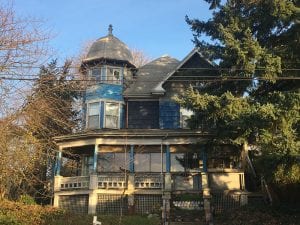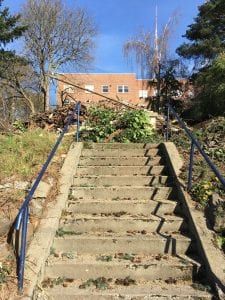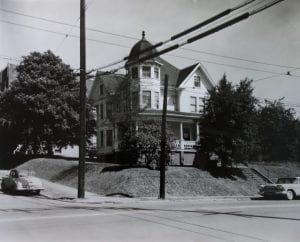Death of a Landmark: The Sullivan House
It took only a couple hours (if even that) to demolish the 122 year-old Sullivan House on Capitol Hill the morning of March 18. This historic home, prominently situated on the southeast corner of 15th Avenue and E. Olive Way, was a designated Seattle Landmark. The house was built in ca. 1898 for Patrick J. and Joanna Sullivan. P.J. Sullivan was the proprietor of Queen City Boiler Works before becoming involved in real estate development. The house was designed in the Queen Anne style by the prominent architecture firm of Josenhans and Allan, credited for designing notable works such as the Marion Building at 818 2nd Avenue, the C.C. Cawsey House at 325 West Kinnear Place West, as well as Lewis, Clark, and Parrington Halls on the University of Washington campus.
The property was listed for sale in 2017 for $2.2M, a price that did not reflect the decades of deferred maintenance of the house. It was a prime candidate for renovation and some TLC but the asking price was cost prohibitive, leaving the property vulnerable to market forces. Seeking a way to preserve the historic house, a Seattle architect and Capitol Hill neighbor submitted a landmark nomination application in 2017 without support from the owner (the owner’s consent is not required to landmark a building in Seattle).
The Sullivan House was designated a landmark by the Landmarks Preservation Board (LPB) in 2018. Its designation was supported by Historic Seattle and many in the Capitol Hill community. We supported the nomination and designation of the Sullivan House because it embodied the distinctive characteristics of the Queen Anne style, represented an outstanding work of the architecture firm of Josenhans and Allen, and was situated prominently at the southeast corner of 15th Ave and E Olive Way, presenting a striking contrast to surrounding buildings.
After the building was designated on February 7, 2018, the owner and the LPB staff entered into negotiations for a “Controls and Incentives” agreement. Controls are what protect a landmark’s designated physical features. Incentives are financial benefits and zoning and building code relief available to owners of landmarked properties. Historic Seattle advocated for controls to be placed on the Sullivan House through a detailed analysis and pro forma demonstrating that the property, as a designated landmark with controls, could still provide a reasonable rate of return to an owner or investor. We felt it was important to conduct this analysis because two other recently designated landmarks (the Galbraith House and the Wayne Apartments) had no controls placed on them, paving the way for demolition. We did not want to see another historic property face the same fate.
At its September 19, 2018 meeting, the Board voted to place controls on the property. This victory was short-lived, however, as the owner appealed the Board’s decision to the Hearing Examiner. In early 2019, the owner and the City of Seattle settled and controls were lifted – leaving no protections for the Sullivan House. The decision not to place controls was the result of a “Stipulation and Proposed Recommendation and Order” signed by the Hearing Examiner at the request of the City Attorney and legal counsel for the owner. The stipulation claimed that “Controls will prevent the Estate from realizing a reasonable return on the property…”
Historic Seattle strongly disagreed with this conclusion because we demonstrated to the Landmarks Preservation Board (in a public comment letter containing well-reasoned analysis) that controls would not prevent a reasonable return on the property. Real estate finance is not an exact science. What one developer finds to be an acceptable rate of return, another may find unacceptable. Other factors that come into play, such as market value, cap rate, comparables, etc. are all malleable.
The Sullivan House was the third landmark to be designated without controls in just over a year. The landmark Galbraith House (also on Capitol Hill) was demolished in January 2018 because it had no controls. It has now been over two years and the site of the Galbraith House is still vacant, as a replacement project has yet to be built. Controls were not placed on the landmark Wayne Apartments in Belltown in 2018, and its days are numbered as well because the property is for sale and may be under contract with a developer.
Until the last couple of years, it had been rare for the Board to place no controls on a designated landmark. We know these must have been difficult decisions for the Board and City staff. What’s not helping is the current, overinflated market value of properties in Seattle and the trend of “demolition-by-neglect” by owners who let their properties deteriorate to the point where rehabilitation is much more expensive than if the properties had been maintained over the years. If a developer or property owner can show no “reasonable economic use” for a designated property, then the death knell will surely sound for the landmark.

The deteriorating Sullivan House as it appeared toward the end of its life. Photo courtesy of Seattle Dream Homes.
The Sullivan House had been converted to a five-unit apartment building in 1949, offering affordable rents for 70 years until it was sold in 2019 to a private developer for just under $2.2M. A victim of neglect and development pressure, it will be replaced by eight townhomes which will be sold for market rate.
The demolition of the Sullivan House will not be in vain. We will learn from this as we work to protect other designated landmarks where controls are not yet in place, because this cannot be the new normal for our city’s historic places. Something needs to change. Historic Seattle and our community partners in preservation hope to work with the City to look for ways to improve the Landmarks Preservation Ordinance so that it can provide the legal protections needed for our city’s historic places.
Historic Seattle’s landmarking of The Showbox is now in the controls and incentives phase. We are doing all we can to demonstrate that as a designated landmark with controls, the Showbox property will still provide an owner or investor reasonable economic use. Landmarks deserve protection, not plaques.

The “stairs to nowhere” on the site of the now-demolished Sullivan House
